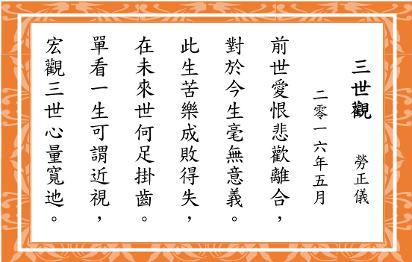
Etymology of Spiritual
Terms 基本术语的词源
A clear definition and
meaning of terms used by various religions is achievable based on their
etymological root analyses. When
the semantics are unambiguous, spirituality from diverse traditions can be
unified.
Since ancient times, humans
try to figure out humanity’s place in, and relationship to, the heavens. The
Western world views rely on creator God as the answer.
|
Western Cultures |
In the Universe 天 (宇宙) |
In Humans人 |
|
(Mono- and poly-)Theism |
God (Holy spirit, holy
ghost) |
Spirit/ ghost/soul |
The Eastern world views
philosophize on Natural Laws. Religions emerged when the philosophy on natural
laws were revered as divine and thus became anthropomorphic deities.
|
Eastern Cultures |
In the Universe 天 (宇宙) |
In Humans人 |
|
文天祥 Wen Tianxiang |
正氣 (Righteousness) |
浩然 (Awe) |
|
老子Lao Tzu/Daoism |
道 (理) Dao |
德 (行) virtue |
|
印度 Hindi |
Pran 般 (能) |
Prajna 般若 (量) |
|
Dharm 規律 |
Dharma 法 |
|
|
Karm 作 |
Karma 業/业 |
|
|
Tathāgatagarbha 如來藏 |
Alaya 阿賴耶識 |
|
|
哲学 Philosophy |
Ontology 本体论, metaphysics 形而上学, Dharmakaya法身 |
Phenomenology 现象界, physics 物理学, Dharmadhatu法界 |
(1) In the above table, the placement of “Righteousness” and “Awe” under
their respective column is merely grammatical. They should be reversed so that
the theological meaning makes sense literally; i.e. Awe of the universe
descends into righteousness in humans.
(2) Dao means the way, natural law that governs the actions of the universe.
In humans it descends into moral virtue that governs human behaviour.
(3) A Hindi word, Pran Means "breath" in Sanskrit; Prana/Prajna is
a life-giving force.
(4) Dharm is now replaced by Dharma means "cosmic law and order",
Dharma is teachings of the Buddha. In Hinduism it means 'duty', 'virtue', 'morality', even 'religion' and it refers to
the power which upholds the universe and society. Hindus generally believe that dharma was revealed in the Vedas although a more common word there for
'universal law' or 'righteousness' is rita. Originally, Dharm means framework
or uphold.
(5) The Hindi word KARM means action/deed. Karma (Sanskrit: कर्म; Pali: kamma) means action, work or deed; it
also refers to the spiritual principle of cause and effect where intent and
actions of an individual (cause) influence the future of that individual
(effect). It means fate. In brief, action (Karm) produce residues (reaction)
call karma, immediately or over time.
(6) Placement of the two terms Tathāgatagarbha 如來藏 and Alaya 阿賴耶識 in the above table conforms to current mainstream Buddhist teaching,
which is in error probably as a result of corruption of the teaching after
thousand years of broken lineage transmission. The correct placement should be
Alaya 阿賴耶識 under the
Universe column and Tathāgatagarbha 如來藏 under the Human column. The Etymological explanations for rectifying this mistake are as
follows.
Tathāgatagarbha is exclusively a Mahāyāna
concept (Buddha-Matrix, Buddha-Embryo, Buddha-Essence, literally “the womb of
the thus-come-one”) within all sentient creatures; “the womb” or
"embryo" (garbha) of the "thus-gone" (tathagata), or “containing a
tathagata”. In short, it means the unborn Buddha, the potential for
enlightenment, in everyone.
The Buddhist term “ālaya-vijñāna” which roughly
translates to the “storehouse consciousness” with “ālaya” meaning “dwelling, abode” and
“vijñāna” meaning “consciousness”. The Eight types of Consciousness is a classification
developed in the tradition of the Yogacara school of Buddhism. They enumerate
the five senses, supplemented by the mind, ego (defilements of the mind), and
finally the fundamental store-house consciousness, which is the basis of the
other seven. http://translation.babylon-software.com/english/alaya/
(Ālaya) A Sanskrit word meaning “place” or
“abode,” but used in Northern Buddhism to refer to the Universal Soul; A
Buddhist term that means the Universal Soul, the anima mundi, or soul
of the world. It is derived from the Sanskrit “a”, not, and “laya”, dissolve,
hence the “indissoluble.” In its essence, Alaya is changeless, thus equivalent
to MULAPRAKRITI, but in its lower aspects it is subject to change. During its
manifestation, the consciousness of Dhyani-Buddhas or even high Yogis can merge
with it. Thus in the Yogacara tradition, the spiritual self of high yogis or progressed
adept is also called Alaya.
Ultimate
Reality
|
|
Ultimate Reality |
究竟实相 |
|
1-5 |
Premises: 1.
All matters are energy (i.e. all physical are metaphysical). 2.
All energy is information (i.e. thermodynamics). 3.
Information is encoding in the language of geometry (e.g. black hole entropy). 4.
All information carries meaning (i.e. low entropy, order). 5.
All meanings are only meaningful to a conscious being or observer (e.g.
Availability of which-way information in a double slit experiment). |
前提: 1. 一切物质都是能量(即所有事物本体都是形而上的)。 2. 一切能量都是信息(即热力学)。 3. 信息是以几何语言编码(例如黑洞熵)。 4. 一切信息都具有意义(即低熵,秩序)。 5. 一切含义仅是对有意识者或观察者才有意义(例如,双缝实验中的有没有量子位置信息)。 |
|
|
Conclusion: Therefore,
consciousness and information must coexists hand-in-hand. |
结论: 因此,意识和信息必须并存。 |
|
6 |
The universe evolves
and life on earth evolves. This is observable phenomenology. |
宇宙演变和地球上的生物進化,这是可观察的现象学。 |
|
|
Deduction: Premise
#6 can be rewritten as “information and consciousness co-evolve”. This is
ontology. |
演绎: 前提#6可以重写为“信息和意识共同演变”。 这是本体论。 |
|
7 |
Space-time
is an emerging phenomenon from the most fundamental stuff
information-consciousness, which is the ultimate reality. |
信息和意识是最终的现实,时空只不過是從这最根本的东西產生的新兴现象。 |
|
8 |
When
space-time is out of the question, the concept of forward causation, which is
space-time dependent, is also out of the question. |
当时空不成立為根本,依赖时空的前因後果关系的概念也不能成立。 |
|
9 |
Causation can be
retroactive (e.g. delayed choice quantum eraser double slit experiment).
Future events influence past records. |
倒果为因现象成立,未来可以影响过去(例如双缝实验里的延迟选择擦掉量子位置信息)。 |
|
|
Induction: Viewing this
co-evolution as a feedback loop, information-consciousness self-creates and
self-perpetuates. There is no beginning or creator because there is no
restriction on causation. |
归纳: 因为因果关系没有前后限制,所以" 始终"这个概念不成立。因此信息和意识自我创造和自我维持,共同演变反馈循环,无需要有开始或创建者。 |
|
|
Conclusion: In layman's
term, all unconscious and conscious beings cause collective consciousness (God)
to exist and evolve and vice versa
in a feedback loop; collective consciousness (God) causes all conscious and
unconscious beings to exist and evolves and vice versa in a feedback loop. |
结论:用常人惯性思维框内的一般语言摸式说法: 所有无意识的物质和有意识的生命都会导致集体意识 (上帝) 存在和演变,反之亦然。集体意识 (上帝) 创造一切物质和生命并促进其进化,反之亦然。 佛家术語: 情與無情,同圓種智。 |
|
|
注: 种 =
DNA= information = 编码 = 信息 = 能量 = 物质 = prakriti (nature)。 智 = 意识 = 觉识 =
consciousness = purusha
(spirit)。 圆 = 圆圈 = 无始终 = feedback loop。 |
|
|
|
佛家宗派: 法相唯识宗
Buddhist Yogacara consciousness-only. 印度教僧佉 (數論 ) 派 / 瑜伽派 Hindu Sankhya / Yoga Philosophy. |
|
